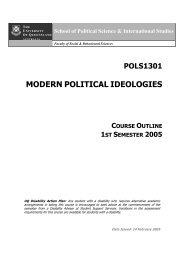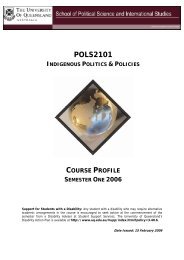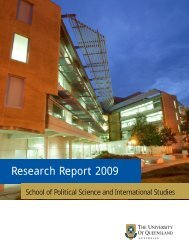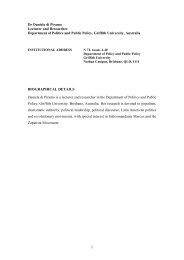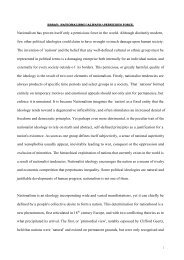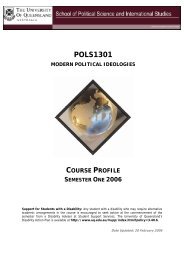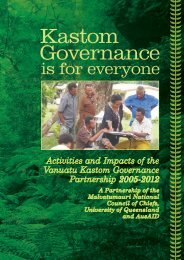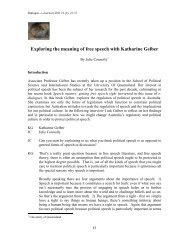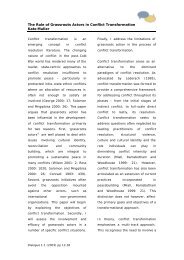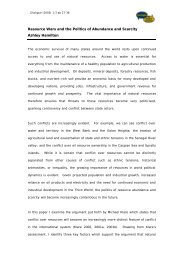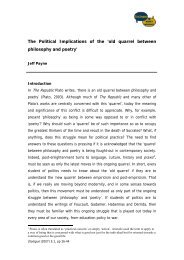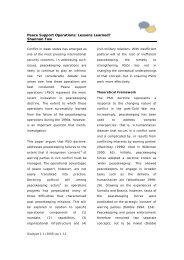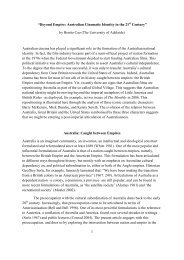CITATION GUIDE FOR CONTRIBUTORS TO DIALOGUE In ...
CITATION GUIDE FOR CONTRIBUTORS TO DIALOGUE In ...
CITATION GUIDE FOR CONTRIBUTORS TO DIALOGUE In ...
You also want an ePaper? Increase the reach of your titles
YUMPU automatically turns print PDFs into web optimized ePapers that Google loves.
<strong>CITATION</strong> <strong>GUIDE</strong> <strong>FOR</strong> <strong>CONTRIBU<strong>TO</strong>RS</strong> <strong>TO</strong> <strong>DIALOGUE</strong><br />
<strong>In</strong> Dialogue, we recommend that authors follow the system used by the Australian Journal of Political Science which<br />
is the official journal of the Australasian Political Studies Association. This system, a variant of the Harvard system,<br />
uses citations within the text that enables the reader to locate the item in a reference list (included at the end of the<br />
document). For more information see http://www.polsis.uq.edu.au//materials/psis-essay-guide-2007.pdf<br />
<strong>CITATION</strong>S<br />
The basic citation in the Harvard system consists of the last name of an author and the year of publication of the<br />
work, followed by the page numbers (see examples below). Under this system, terms such as ibid. and op. cit. are<br />
not used, and you should not use p., pp. and page to indicate the page numbers.<br />
Here are some examples of citations:<br />
Australia’s political culture has been characterised as consisting of compliant subjects rather than active<br />
citizens who genuinely participate in the country’s civic life (Smith 2001: 27).<br />
Jacobs (2002: 6) initially advanced this idea, and it was later developed in the United States (Brown 2005:<br />
92).<br />
Where the words of an author are quoted directly, this must be indicated by enclosing the words in quotation marks.<br />
All quotations must have an in-text citation, including a page number:<br />
Ruling classes “do not justify their power solely by de facto possession of it, but try to find a moral and<br />
legal basis for it” (Mosca 1939: 70).<br />
Where an author’s name is mentioned in the text, it does not need to be repeated in the in-text citation:<br />
Friedrich insists that “constitutionalism, both in England and abroad, was at the outset not at all<br />
democratic” (1937: 31).<br />
Where a direct quotation of an author’s work is drawn from another source this should be indicated in the text:<br />
The central question of political science has been formulated as ‘who gets what, when and how?’ (Lasswell<br />
1936, cited in Dunleavy and O'Leary 1987: 18).<br />
When citing an anonymous article from a newspaper or website, you must include the title of the publication,<br />
webpage or website. Do not cite a web address or URL in the text.<br />
Canadian opinion polls indicate that the Opposition will win the next election (The Economist 2006: 12).<br />
If the article has a ‘by line’ (author), cite the journalist as you would the author of a text.<br />
There is widespread resentment within the Liberal Party about the perceived poor performance of National<br />
Party ministers (Shanahan 2006: 1).<br />
When more than one study is cited, arrange the references in alphabetical order and separate them with semicolons.<br />
A number of researchers (Bennett 1997:142; Dent 1999, 2000; Yates 1999) have advanced this argument;<br />
however, others support an alternative view (Abato 2005; North 2004: 256-260).<br />
Use commas to separate two works by the same author. If works by the same author are also published in the same<br />
year, add lower case letters to the dates of publication and repeat these in the reference section.<br />
This theory was originally advanced in two articles (Habermas 2000, 2001) which...<br />
Vromen (2003a, 2003b, 2004) has strongly criticised the idea that young people...<br />
When citing publications with no obvious author, such as government reports, cite the sponsoring body. If this body<br />
has a cumbersome or long name (such as the Australian Bureau of Statistics) cite it in abbreviated form.<br />
The level of unemployment fell from 11.1% to 5.2% between 1993 and 2003 (ABS 2005: 3).<br />
If there are two or three authors, cite all names in every reference. If there are four or more authors, et al. (meaning<br />
‘and others’) should follow the first author’s name in the citation. If two or more authors have the same last name,<br />
the first initial should be used to distinguish between them.<br />
The idea was originally advanced by Arndt, Wee and Smart (1985). <strong>In</strong>dependently, other scholars (Drew et<br />
al.1987) advanced a similar idea, which was criticised by Irish researchers (R. Smith 1990; J. Smith 1992).<br />
Nonetheless, the idea gained acceptance in Ireland (Dent 1999) and overseas (Eckhart 2002: 131-150).<br />
Where you are citing or quoting from a chapter in an edited book you must cite the author of the chapter in the text<br />
and include the author and title of the chapter in your reference list, not just the editor(s) of the book. For example,<br />
a 2002 book by Bell has a chapter by Beeson and Capling. The chapter is cited in the text as (Beeson and Capling<br />
2002), not as (Bell 2002).<br />
When citing legislation, the format to follow is Title Year (Abbreviation of Jurisdiction). The Commonwealth is<br />
abbreviated ‘Cth’. For example:<br />
The University is governed by the University of Queensland Act 1998 (Qld), which requires….<br />
Shortly before the 2004 federal election, the Howard government moved to ban same-sex marriage in<br />
Australia by passing the Marriage Amendment Act 2004 (Cth).
Footnotes are not used for the purpose of citations; however, they can be used sparingly to expand on points in<br />
the text. Notes should be numbered consecutively and placed at the end of the essay (‘endnotes’) or at the bottom<br />
of the page (‘footnotes’). The corresponding note number in the text should be typed as a superscript.<br />
REFERENCE LIST<br />
Citations in the body of the text refer to the more detailed Reference List, which should be placed at the end of your<br />
essay. The Reference List should provide an accurate, alphabetically sequenced and complete account of the<br />
sources you have consulted and/or cited in the essay.<br />
Reference lists should be presented in the following style:<br />
• List all references alphabetically by author’s surname. After the surname, list the full first name of the author<br />
(unless they are widely known only by their first initial).<br />
• After the author name/s, list the year of publication. Multiple publications by the same author should be listed in<br />
date order, with the earliest first. Where there are two or more publications by the same author in the same year,<br />
separate publications are indicated by lower-case letters: Cox, Gary 2002a. Cox, Gary. 2002b.<br />
• After the date of publication, list the title of the book or the name of the journal article followed by the title of the<br />
journal. The edition of a book should be indicated if it is not the first edition. Book and journal titles should be<br />
italicised or underlined. The name of journal articles should be placed in single quotation marks.<br />
• For books, the title is followed by the place of publication (use the city, not the suburb; for example, Brisbane, not<br />
St Lucia) and the name of the publisher. Cities which have obscure or common names may be followed by a country<br />
or state identifier (Cambridge, UK or Cambridge, MA).<br />
• For journal articles, the title of the journal is followed by the volume number, issue number (if any) and page<br />
numbers.<br />
EXAMPLES<br />
Here are some examples of how to correctly reference books, journals and other materials. Please take careful<br />
note of the placement of commas, full stops and colons.<br />
BOOKS<br />
Gorard, Stephen. 2003. Quantitative Methods in Social Science. London: Continuum.<br />
Baylis, John and Steve Smith, eds. 2005. The Globalization of World Politics: An <strong>In</strong>troduction to<br />
<strong>In</strong>ternational Relations, 3rd ed. Oxford: Oxford University Press.<br />
JOURNAL ARTICLES<br />
Mackenzie, Chris. 2004. ‘Policy Entrepreneurship in Australia: A Conceptual Review and Application’.<br />
Australian Journal of Political Science 39(2): 367-386.<br />
Walt, Stephen. 2005. ‘The Relationship between Theory and Policy in <strong>In</strong>ternational Relations’. Annual<br />
Review of Political Science 8: 23-48.<br />
PUBLICATIONS WITH MULTIPLE AUTHORS<br />
Citrin, Jack, Eric Schickler and John Sides. 2003. ‘What if Everyone Voted? Simulating the Impact of<br />
<strong>In</strong>creased Turnout in Senate Elections’. American Journal of Political Science 47(1): 75-91.<br />
Singleton, Gwynneth, Don Aitkin, Brian Jinks and John Warhurst. 2006. Australian Political <strong>In</strong>stitutions, 8th<br />
ed. Melbourne: Longman.<br />
EDITED BOOKS<br />
Galligan, Brian, ed. 1989. Australian Federalism. Melbourne: Longman Cheshire.<br />
Ward, Ian and Randall Stewart, eds. 2006. Politics One, 3rd ed. Melbourne: Palgrave Macmillan.<br />
CHAPTER IN AN EDITED BOOK<br />
Beeson, Mark and Ann Capling. 2002. ‘Australia in the World Economy’. <strong>In</strong> Economic Governance and<br />
<strong>In</strong>stitutional Dynamics, ed. S. Bell. Melbourne: Oxford University Press.<br />
Mackerras, Malcolm. 1990. ‘How Unfair is Queensland's Electoral System?’. <strong>In</strong> Corruption and Reform: The<br />
Fitzgerald Vision, eds. S. Prasser, R. Wear and J. Nethercote. Brisbane: University of Queensland Press.<br />
BOOK REVIEWS<br />
A book review published in a journal is cited in the same way as a journal article, but with a comment identifying the<br />
reviewed book’s title and author (if this information is not included in the title of the review). If a review has no title,<br />
then the reviewed book’s title and author is used instead.<br />
Weber, Jennifer. 2006. ‘Andrew Johnson’s Good Deed’. Review of Forever Free: The Story of Emancipation<br />
and Reconstruction, by Eric Foner. The Washington Monthly 38(1): 50-52.<br />
Kirchner, Stephen. 2005. ‘Review of Australia’s Money Mandarins: The Reserve Bank and the Politics of<br />
Money, by Stephen Bell’. Australian Journal of Political Science 40(4): 567-568.<br />
TRANSLATED WORKS<br />
For books which have been translated, the author is the original writer and the translator is identified after the title:<br />
Politkovskya, Anna. 2004. Putin’s Russia. Trans. Arch Tait. London: Harvil Press.<br />
OLDER WORKS<br />
For reprinted editions, both the original date [in brackets] and the reprint date are given.<br />
Popper, Karl. [1945] 2002. The Open Society and Its Enemies. London: Routledge.
UNPUBLISHED WORKS<br />
Unpublished works such as theses or papers presented at a conference are cited like a journal article:<br />
Johnson, Carol. 2002. ‘Australian Political Science and the Study of Discourse’. Paper presented at the<br />
Australasian Political Studies Association (APSA) conference, Canberra.<br />
Ungerer, Carl. 2003. ‘The Force of Ideas: Middle Powers and Arms Control Diplomacy after the Cold War’.<br />
PhD thesis. University of Queensland.<br />
NEWSPAPERS & MAGAZINES<br />
Newspapers and magazines also follow the same format as journal articles. The only difference is that the date of<br />
the newspaper is given where you would usually place the volume or issue number of a journal. <strong>In</strong>clude the page<br />
number(s) if known. The Library’s Factiva database reports page numbers for nearly all newspaper articles.<br />
Cloud, John. 2005. ‘The Battle over Gay Teens’. Time 10 October: 40-47.<br />
Stevenson, Richard. 2006. ‘<strong>In</strong> Address, Bush Is Seen Avoiding Large <strong>In</strong>itiatives’. The New York Times 26<br />
January: 1.<br />
Where the source is an anonymous article, the title of the publication takes the place of the author’s name.<br />
The Australian. 2006. ‘Europe Softens Stance on Iran’. 19 January: 8.<br />
If there are two anonymous articles from a newspaper from the same year, they are referenced as:<br />
The Australian. 2006a. ‘Europe Softens Stance on Iran’. 19 January: 8.<br />
The Australian. 2006b. ‘McCain slips into poll position over Clinton’. 23 January: 10.<br />
<strong>In</strong> the text of your essay, the citation would be in the form:<br />
Senator John McCain is leading fellow Senator Hillary Clinton by 18 points in a hypothetical 2008<br />
presidential match-up (The Australian 2006b).<br />
PARLIAMENTARY & GOVERNMENT PUBLICATIONS<br />
Government publications, papers and reports have the same format as for books. <strong>In</strong>clude individual authors or<br />
editors if they are identified:<br />
Manning, Ben and Roberta Ryan. 2004. Youth and Citizenship: A Report for the National Youth Affairs<br />
Research Scheme. Canberra: Department of Family and Community Services.<br />
For publications with no known author, the organisation’s name is listed as the author. If this name has been<br />
abbreviated in the in-text citation, reference it in full, followed by the abbreviation in parentheses.<br />
Australian Bureau of Statistics (ABS). 1995. The Labour Force, Australia, June 1995. Canberra: ABS.<br />
Department of Foreign Affairs and Trade (DFAT). 2005. Annual Report 2004-2005. Canberra: AGPS.<br />
References for parliamentary publications in a series, such as journals, votes and proceedings, parliamentary debates<br />
and parliamentary papers, often have titles which are long and vary widely over time and between different states. It<br />
is therefore convenient to use a simplified form of reference that gives the jurisdiction and legislative body as the<br />
author, followed by the date, series title, issue or volume number and page numbers(s). For example:<br />
Australia, House of Representatives. 2004. Votes and Proceedings 191: 1815.<br />
Australia, Senate. 2005. Journals 68: 1762-1765.<br />
INTERNET REFERENCES<br />
The format for sources from the internet follows similar principles to those for printed sources: Author’s surname,<br />
Author’s first name. Year of publication or year last updated. Title of publication or webpage or website (as<br />
appropriate). Accessed on: Date you viewed the site. Available at: Site address (URL). Identify an author if possible.<br />
Otherwise, use the organisation which owns or sponsors the website as the author. Here are some examples:<br />
Bush, George. 2005. President’s Address to the Nation, 18 December 2005. Accessed 25 January 2006.<br />
Available at http://www.whitehouse.gov/news/releases/2005/12/20051218-2.html.<br />
Human Rights and Equal Opportunity Commission (HREOC). 2005. Aboriginal and Torres Strait Islander<br />
Justice. Accessed 20 December 2005. Available at http://www.hreoc.gov.au/social_justice/index.html.<br />
Duff, David. 2005. ‘The Abolition of Wealth Transfer Taxes: Lessons from Canada, Australia and New<br />
Zealand’. University of Toronto, Legal Studies Research Paper No. 05-08. Accessed 27 January 2006.<br />
Available at http://papers.ssrn.com/sol3/papers.cfm?abstract_id=719744.<br />
These sources are cited in the essay in the normal way, for example as (Bush 2005). Reference page numbers if<br />
they exist, although many internet sources will consist of a single webpage with no page numbering.<br />
E-Journals<br />
For newspaper, magazine and journal articles accessed through the internet, it is not necessary to cite the URL<br />
unless the source exists only in an electronic from. So an article (here with no author) from The Australian’s<br />
website is cited in the same way as if it were from the hard-copy edition:<br />
The Australian. 2006. ‘Europe Softens Stance on Iran’. 19 January: 8.<br />
However, an article from an electronic-only source such as an e-journal or news site should include the URL:<br />
Reibelt, Rebecca. 2005. ‘Gender and the Queensland Legislative Assembly’. Dialogue 3(1): 80-134.<br />
Accessed 25 January 2006. Available at http://www.polsis.uq.edu.au/dialogue/vol-3-1-3.pdf.<br />
CNN. 2006. ‘Election likely means closer Canada, US ties’. Accessed 25 January 2006. Available at<br />
http://www.cnn.com/2006/WORLD/americas/01/24/canada.election.ap/index.html.
Blogs, Newsgroups, Email Lists, Discussion Boards<br />
These informal internet sources are seldom appropriate as references in academic writing. They should not be used<br />
as a secondary source. Occasionally, they might be a legitimate primary source (for example, for an essay on a<br />
political leader, it might be appropriate to cite that person’s own blog or one by a colleague). The format is the same<br />
as for other internet sources. For example, a blog is cited like an e-journal:<br />
Schlesinger Jr., Arthur. 2005. ‘Patriotism and Dissent’. The Huffington Post 14 November. Accessed 25<br />
January 2006. Available at http://www.huffingtonpost.com/arthur-schlesinger-jr/patriotism-anddissent_b_10642.html.



